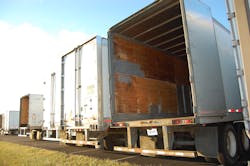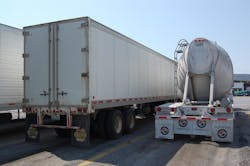As fleets continue to “fine tune” their equipment investment plans for 2017, trailer orders are expected to stay strong, though trend comparisons with 2016 remain difficult due to changes in order timing last year, while backlogs are still extended relative to historical norms, according to Michael Baudendistel, vice president of the Stifel Transportation & Logistics Research Group.
In research note, he said trailer orders declined sequentially from March to April are still well above prior-year levels – a trend that’s now been in place for the last five months.
As a result, Stifel is increasing its trailer production estimate slightly to 275,000 total units from 265,000 for 2017 to reflect expectations that orders will remain above 2016 levels in the coming months, though they are likely continue falling sequentially due to seasonality.
“Our updated 2017 production estimate of 275,000 units represents a 4% year-over-year decline from 2016 production of 288,000 units,” Baudendistel pointed out. “While that is a steeper decline than orders currently imply, we believe that is a reasonable assumption as production started the year weak—though we expect strengthening in build rates, in excess of normal seasonality, as the year goes on.”
That view is echoed by Frank Maly, director of CV transportation analysis for ACT Research, who noted that his firm’s preliminary estimate for net trailer orders in April is 20,200 units.
“While net orders were off approximately 6% from March, industry patterns actually call for some softening in volume as we exit the industry’s normal ‘order season,’” he explained. “On that basis, the April month-over-month decline is actually a bit less than we would have expected.”ACT’s data indicated that April orders were 22% above the same month in 2016 – the fifth straight month of stronger volume on a year-over-year basis.
“The 2016/17 order season started slow, but gained momentum as it progressed,” Maly added. “That momentum appears to have carried into April, as fleets continue to fine-tune their investment plans for this year.”
Based on those trends, he expects dry van production to continue posting solid numbers, while flatbeds appear to have garnered the best year-over-year order growth, on a percentage basis, according to the April figures.
Research firm FTR Transportation Intelligence reported similar April net trailer order data of 20,000 units, down 4% month-over-month but up 26% versus April of 2016. Backlogs fell 2% and are 16% below a year ago; production remained steady from March on a per day basis, noted Don Ake, FTR Vice President of Commercial Vehicles, in a statement.
“Fleets are continuing to place orders for second-half 2017 delivery with dealer orders also brisk for the month,” he noted. “Dry van order activity was down marginally from April and refrigerated vans orders also eased off a bit.”
Still, Ake stressed that the trailer market held on to its strong production gains from the month of March, which he believes is a “great sign” for future sales.
“Orders were less than production for the second straight month, which means backlogs are easing down,” Ake noted. “This is consistent with seasonal trends in a healthy, normal market. The second quarter looks to be robust, based on April’s production rates and the respectable backlog levels. Orders will fall off in the summer, but 2017 will be a better year than expected.”
That’s due in part to what he characterized as “growing optimism” about freight levels as this year progresses.
“Fleets are replacing old equipment and adding some new units now in anticipation of a stronger business environment,” he pointed out. “The dry van sector remains vigorous and flatbeds show signs of a better second half, [while] the resumption of activity in the oil fields is aiding the tanker markets.”
About the Author
Fleet Owner Staff
Our Editorial Team
Kevin Jones, Editorial Director, Commercial Vehicle Group
Cristina Commendatore, Executive Editor
Scott Achelpohl, Managing Editor
Josh Fisher, Senior Editor
Catharine Conway, Digital Editor
Eric Van Egeren, Art Director

